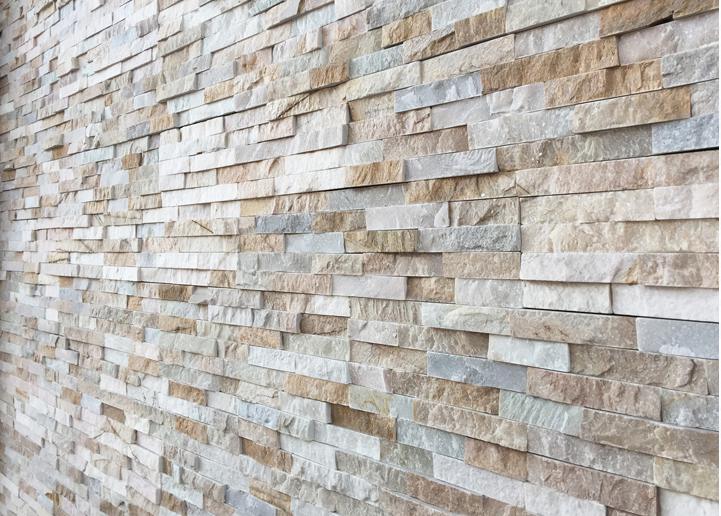Choosing the right wall cladding can be a headache. Do you prioritize the unique look of natural stone or the consistent appearance and potentially lower cost of faux stone? For homeowners and builders, this decision impacts not just aesthetics but also long-term value and maintenance.
This guide cuts through the confusion in the real vs. faux stacked stone debate. We’ll break down the key differences—from durability and environmental impact to cost and installation—so you can make an informed choice. With over 15 years of experience in manufacturing quality stacked stone ledger panels, Top Source Stone understands the importance of balancing beauty and long-term performance.
Decoding Real Stacked Stone: Authenticity and Advantages
Using real stacked stone can add lasting beauty and value to any project, providing a unique, natural aesthetic that faux materials simply can’t replicate.
When it comes to enhancing the aesthetic appeal and durability of construction and design projects, the choice between real vs. faux stacked stone can be a critical decision. Real stacked stone offers a unique blend of natural beauty and lasting resilience that synthetic alternatives struggle to match. Let’s explore what makes real stacked stone a superior choice, diving into its origins, benefits, and proper installation techniques. I’m Coco from Top Source Stone, and with my 15 years of experience, I’m here to guide you through the ins and outs of selecting the perfect stone for your project.
Sourcing and Formation: Understanding the Natural Origins
Natural stacked stone begins its journey deep within the earth, formed over millennia through geological processes. Quarried from mountains and natural deposits, each piece tells a story of time and pressure. This natural formation results in unique variations in color, texture, and pattern, ensuring that no two installations are ever exactly alike. Top Source Stone is strategically located in Hebei province, China, known for its rich stone resources. This allows us to source premium materials directly, ensuring top-notch quality.
Aesthetic Uniqueness: Variations in Color, Texture, and Pattern
One of the most compelling advantages of real stacked stone is its unparalleled aesthetic uniqueness. The natural variations in color, texture, and pattern create a visually dynamic surface that adds depth and character to any space. Unlike faux stone, which often features repetitive patterns, real stone offers an organic, authentic look that enhances both interior and exterior designs. Imagine accent walls that truly stand out or building facades that exude natural elegance. As we say, “there’s no place like stone.”
Durability and Longevity: Why Real Stone Stands the Test of Time
Real stacked stone is renowned for its exceptional durability and longevity. Formed under immense pressure, natural stone can withstand the rigors of time and weather, making it an ideal choice for both interior and exterior applications. Unlike synthetic materials that may fade, crack, or degrade over time, real stone maintains its integrity and beauty for generations. This longevity translates to long-term cost savings, as real stone requires minimal maintenance and replacement. Top Source Stone ensures each piece is crafted to exacting standards, guaranteeing lasting beauty and performance.
Installation Best Practices for Real Stacked Stone
Proper installation is crucial to maximizing the benefits of natural stacked stone. The process typically involves preparing the surface, applying a bonding agent, and carefully arranging the stones to create a seamless, visually appealing surface. While it may require more skill and effort than installing faux stone, the results are well worth the investment. For those looking into how to install real stacked stone veneer, remember that precision and attention to detail are key. Our direct-from-factory business model ensures you receive not only premium quality but also expert guidance on installation best practices.
In conclusion, while faux stone may offer a lower initial cost, real stacked stone provides unmatched aesthetic appeal, durability, and long-term value. Understanding the stone veneer benefits can guide homeowners to make an informed decision. At Top Source Stone, we are committed to providing high-quality, authentic stacked stone solutions that elevate your projects. Our extensive product portfolio and customization options ensure that you’ll find the perfect stone to meet your specific needs. Consider the enduring beauty and value of real stacked stone for your next project.
Unveiling Faux Stacked Stone: Cost-Effectiveness and Versatility
Faux stacked stone provides an affordable and versatile alternative to natural stone, making it a popular choice for budget-conscious projects.
In the world of construction and design, balancing aesthetics with budget is a constant challenge. That’s where faux stacked stone comes in as a practical alternative. Let’s dive into the composition, benefits, and best applications of faux stone panels. While real vs. faux stacked stone each have their place, understanding the strengths of faux stone is key to making an informed decision. I’m Coco from Top Source Stone, and with my 15 years of experience in the stacked stone industry, I’m here to share my insights.
Manufacturing Processes: How Faux Stone is Created
Manufactured stone veneer, often called faux stone, is created through a meticulous process. It typically involves molding a mixture of concrete, aggregates, and pigments to replicate the look and feel of natural stone. These molds are often crafted from actual stone to ensure a realistic texture and appearance. The resulting panels are lighter and easier to handle than real stone, simplifying installation. Top Source Stone is exploring opportunities to offer these cost-effective alternatives, ensuring quality even in budget-friendly options.
Cost Savings: Analyzing the Economic Benefits of Faux Stone
One of the most significant advantages of faux stone is its cost-effectiveness. The faux stone vs real stone cost comparison often reveals substantial savings, making it an attractive option for projects with tight budgets. The lower material costs, combined with reduced installation expenses due to its lighter weight, can significantly impact the overall project budget. For homeowners and contractors alike, this can translate to considerable savings without sacrificing the desired aesthetic. It’s a smart choice when your wallet is feeling a little strapped.
Design Flexibility: Exploring Patterns, Colors, and Textures
Faux stone offers remarkable design flexibility. It’s available in a wide array of patterns, colors, and textures, allowing for endless design possibilities. Whether you’re aiming for a rustic, contemporary, or traditional look, there’s a faux stone option to match your vision. This versatility makes it suitable for various applications, from interior accent walls to exterior cladding. Top Source Stone’s potential to provide customized faux stone options means clients can achieve their desired look without breaking the bank.
Maintenance and Upkeep: Ease of Care with Faux Stone
Another compelling benefit of faux stone is its ease of maintenance and upkeep. Unlike real stone, which may require sealing and specialized cleaning products, faux stone typically only needs occasional cleaning with soap and water. Its resistance to fading, cracking, and staining makes it a practical choice for high-traffic areas and exterior applications. For those considering installing faux stone panels for exterior walls, the minimal upkeep is a significant advantage. This ease of care ensures long-term satisfaction with minimal effort.
In conclusion, while real vs. faux stacked stone each offer distinct advantages, faux stone stands out as a cost-effective, versatile, and easy-to-maintain alternative. Its design flexibility and affordability make it a practical choice for a wide range of projects. At Top Source Stone, we are exploring ways to provide high-quality faux stone options to meet diverse client needs. Consider the economic and practical benefits of faux stone for your next design endeavor.
Making the Informed Choice: Comparative Analysis and Procurement Considerations
Choosing between real and faux stacked stone involves carefully weighing aesthetic preferences, budget constraints, and long-term maintenance considerations.
Selecting the right material for your project requires a thorough understanding of the options. Let’s analyze real vs. faux stacked stone to help you make an informed choice. This involves comparing aesthetics, durability, cost, environmental impact, and installation. As Coco from Top Source Stone, with 15 years of experience, I’ll guide you through the decision-making process, ensuring you get the best value and quality.
Aesthetic Comparison: Evaluating Visual Appeal
The aesthetic appeal is a primary consideration. Natural stone vs faux stone each offers distinct visual characteristics. Real stone boasts unique, natural variations in color, texture, and pattern, creating an authentic, organic look. Faux stone, while designed to mimic real stone, often presents a more uniform appearance. The key is to assess which look best complements your design vision. Consider the level of authenticity and character you desire for your project. A discerning eye can often tell the difference, but high-quality faux stone can be surprisingly convincing.
Durability and Maintenance: Long-Term Performance Analysis
Durability and maintenance are critical for long-term satisfaction. Real stone is known for its exceptional durability and longevity, withstanding harsh weather and resisting wear and tear. Faux stone, while durable, may be more susceptible to fading, cracking, or chipping over time. Maintenance requirements also differ. Real stone may require sealing and specialized cleaning, while faux stone typically only needs soap and water. A real stone vs faux stone durability comparison reveals that real stone generally outperforms faux stone in the long run, but advances in manufacturing are closing the gap.
Cost Analysis: Upfront vs. Lifetime Expenses
Cost is a significant factor. While real stone generally has a higher upfront cost, its durability and longevity can translate to lower lifetime expenses. Faux stone, with its lower material and installation costs, offers immediate savings. However, consider the potential for repairs or replacements down the road. A comprehensive cost analysis should include material costs, installation expenses, maintenance requirements, and potential replacement costs. Careful budgeting can help you determine which option provides the best value for your investment. Think about balancing initial savings with long-term durability.
Environmental Impact: Sustainability Considerations
Environmental impact is an increasingly important consideration. Real stone is a natural material, but its extraction can have environmental consequences. Faux stone is often made from recycled materials, reducing its environmental footprint. However, the manufacturing process may involve energy-intensive processes. Consider the sourcing and manufacturing practices of your supplier. Top Source Stone is committed to responsible sourcing and sustainable practices, ensuring that our products minimize environmental impact.
Installation Overview: Complexity and Labor Costs
Installation complexity and labor costs vary between the two options. Real stone installation typically requires skilled labor and specialized tools, increasing installation expenses. Faux stone, with its lighter weight and uniform shape, is often easier to install, reducing labor costs. For DIY enthusiasts, faux stone may be a more manageable option. However, professional installation is always recommended to ensure proper adhesion and a seamless finish. Before starting, research how to choose between real and faux stone for your home and get professional opinions.
Ultimately, the choice between real vs. faux stacked stone depends on your specific needs, budget, and priorities. At Top Source Stone, we offer expert advice and high-quality products to meet your requirements. By carefully considering the factors outlined above, you can make an informed decision that enhances the beauty and value of your project. Trust our 15 years of experience to guide you towards the perfect solution.
Conclusion
Choosing between real and faux stacked stone really boils down to what you value most. From my years at Top Source Stone, I’ve seen projects where the authentic look of natural stone was a must-have, and others where faux stone provided the perfect balance of aesthetics and budget.
It’s about weighing those factors—the durability, the cost, and the environmental impact—to make a decision that aligns with your priorities. Ultimately, the ball is in your court to choose what best fits your needs.
Whether you lean towards the timeless appeal of real stone or the cost-effective versatility of faux, remember that the right choice enhances both the beauty and value of your space. I hope my insights have helped guide you toward a solution that exceeds your expectations.


